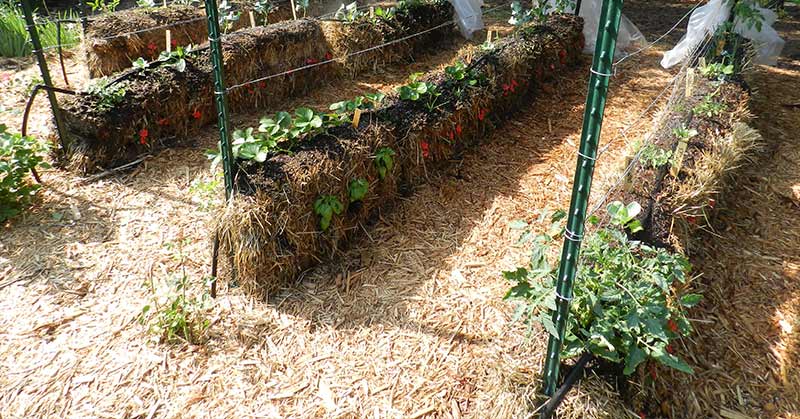Gardening is a great hobby. You get to spend time outside, it’s good exercise for you, and at the end of the growing season, you get beautiful, delicious vegetables! Building a straw bale garden is a great way to start a garden just about anywhere. There are some pros and cons to consider before you run out and grab your straw bales!
Pro: You can garden anywhere
One of the best things about straw bale gardening is that you can do it anywhere. Not everyone has a huge yard that they can dig up for an expansive garden. Some of us have small yards, patios, and balconies – very small spaces. It is not recommended that you straw bale garden on wood surfaces. Straw bale gardens are compact and can be placed anywhere that gets full sunlight. They can be placed on roofs but be careful. When watered, they can get very heavy. Ensure that your roof is strong enough to handle straw bales that can weigh upwards of a couple hundred pounds.
Pro: It’s easier on your body
Straw bale gardening is a great option for seniors in particular who may not want to go through the hassle of building raised wooden beds. Because straw bales stand a foot or two off the ground, you don’t need to hunch and kneel down quite so much when gardening. Straw bale gardens are also tall enough to be accessible to individuals in wheel chairs.
Pro: Straw bales are inexpensive
You can pick up a straw bale from a local feed store or garden center usually for between $5 and $15, making them an extremely economical gardening choice.
Pro: They grow great veggies!
Straw bale gardening works wonders. If you make sure to water and fertilize properly, you’ll grow a regular bounty!
Con: Straw bales may eventually sprout unwanted weeds
In all likelihood, there are straw seeds as well as the seeds of other plants bundled in your straw bale. Once you’ve watered them for a bit, the seeds may begin to sprout. It isn’t hard to simply pull these sprouts as they come up, but it is worth taking into consideration that straw bale gardening isn’t a completely weed-free experience.
Con: Straw bales are difficult to compost
When the season comes to a close, your straw bales will be worse for the wear. They’ll likely be a bit soggy, falling apart, possibly even molding. Your bales can definitely be composted, but they can definitely be a little bit unsightly during the process
Con: Wet straw bales weigh a lot
Even when dry, straw bales can weigh quite a bit. Moving them around is a bit of a challenge, especially if you lack a strong back or have pre-existing injuries that would make it difficult to lift more than 20-30 pounds. Ask for assistance with your garden if you’re not sure you’re strong enough to move your bales into gardening position.
Con: Straw bales may contain pesticides and herbicides
Finally, we recommend seeking out straw bales that are grown organically, meaning no chemical pesticides or herbicides. Conventionally grown straw can bring these chemicals to your home, possibly harming your vegetables’ ability to grow strong and healthy. These chemicals do your compost heap a disservice too and, if you do get vegetables to grow, they can harm you as well!
How to build a straw bale garden
Straw bale gardening is a rewarding experience and a great way to grow vegetables and herbs. As we’ve mentioned, it’s easier on your body, inexpensive, and they work great for growing vegetables. But before you rush out and grab your first straw bales, there are a few tips you should keep in mind.
- Don’t make the mistake of using a hay bale for your straw bale garden. Hay bales will have tons of seeds, making weeding a huge challenge for your garden.
- Make sure you have a spot in your yard with full sun. This will help your vegetables grow.
- Avoid planting very tall plants, like sunflowers, in your straw bale garden. The bales will be fairly heavy once watered, but tall plants can easily topple a straw bale in a high wind situation.
Setting up a straw bale garden is pretty simple.
First, place your straw bales where you want them and make sure that the sheared side is facing up. One side of the bale should look folded over, the other should look sheared off. Once you’ve set your bales up where you want them, spread an all-purpose fertilizer over the tops of your bales.
Once you’ve spread fertilizer, give your bales a thorough watering, allowing the fertilizer to seep into the bales. Repeat the process of adding fertilizer and watering for several days. Once this process has ended, add a 3 inch later of potting soil and compost to the tops of the bales.
Now you’re ready to plant!
Follow planting guidelines for your vegetables, ensuring that you aren’t planting too close together or improperly. Once planted, regularly water your straw bale garden. This could mean every day, especially if you have hot summers. Moisture will readily escape the bales, allowing them to dry out easily.
Once your season is over, toss your straw bales into a compost heap to make fresh, new, fertile soil for your next year’s garden!
Before you start your straw bale garden, consider these 5 common problems with straw bale gardens.













